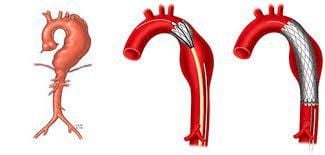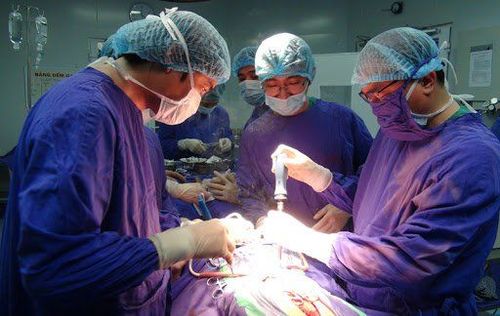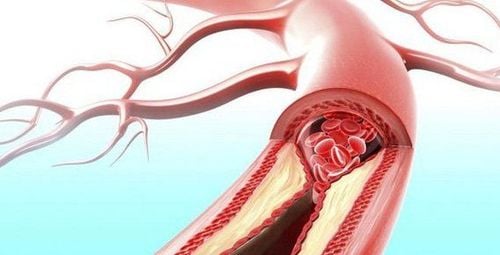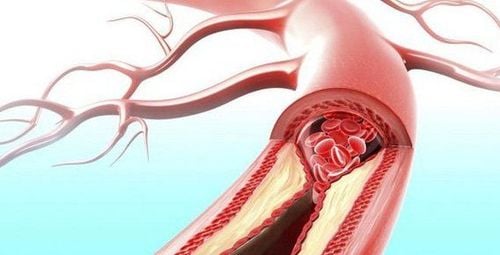This is an automatically translated article.
The article was professionally consulted by Doctor General Internal Medicine Doctor - Department of Medical Examination & Internal Medicine - Vinmec Hai Phong International General Hospital.
Aortic aneurysm is an irreversible dilation of the artery wall with a diameter greater than 50% of the normal diameter of that segment of the artery. If the aneurysm is larger, the risk of rupture is higher, and the aneurysms tend to grow larger and larger, but cannot return to normal on their own. So what is the mechanism of aortic aneurysm formation?
People with a small aortic aneurysm will have no typical symptoms, difficult to recognize. However, when the aorta is enlarged, it will cause symptoms of compression of the organs around the bulge, compressing the artery itself, reducing the blood supply to the organs due to the bulging artery. Besides, the blood flow into the inflator will become a vortex flow, so it is easy to form a blood clot in the inside of the inflator. These clots can break off and float into the bloodstream, blocking an artery elsewhere in the body.
1. Mechanism of aortic bulge formation
Depending on the location of the bulging artery, the patient will have specific diagnostic symptoms as follows:
O segment: from the aortic valve ring to the end of the 2 coronary arteries.
Segment I: from above the coronary artery to the base of the brachial artery stem, the aneurysm may press on the vena cava causing coat edema, collateral circulation in the thoracic region, the aneurysm may rupture into the vena cava. pericardium causing acute cardiac tamponade.
Section II: from the brachiocephalic trunk to the left subclavian artery, the bulge bag is inserted into the superior vena cava, compressing the trachea and main bronchus causing postural dyspnea, coughing.... The bulge can rupture into the trachea or mediastinum causing severe hemoptysis, acute mediastinal compression.
Section III: From the left subclavian artery to the diaphragm, the bulging bag presses into the esophagus causing difficulty swallowing, compressing the left recurrent nerve causing the patient to speak hoarsely, double voice, compressing the blood supply to the patient. Adamkiewicz artery. Besides causing ischemia, paralysis of the lower extremities, bulging sacs can burst into the lungs, pleura causing coughing up blood, acute hemothorax.
IV: From below the diaphragm to the base of the 2 renal arteries, the bulging sac can compress, affecting the blood supply to the kidney, causing oliguria, increased blood pressure, and compression of the gastrointestinal tract organs, causing digestive disorders. In addition, the bulging sac can rupture into the abdominal cavity, the retroperitoneal space causing acute abdominal syndrome.
V segment: from below the renal artery to the division of the main iliac arteries, the bulge can be seen pulsating with the heart rate, the bulge can be palpated, the bulge can be heard, there is a systolic murmur, the bulging sac has a systolic murmur. may rupture into the abdominal cavity or retroperitoneal space.
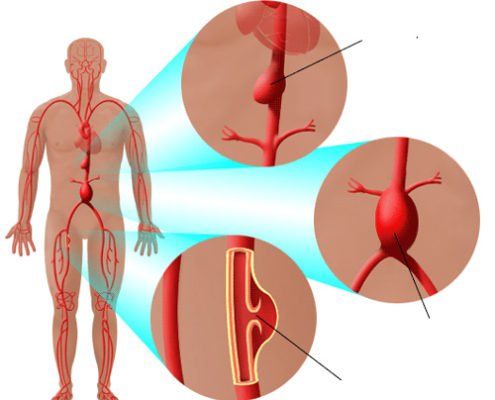
Peripheral artery aneurysms: common popliteal and femoral artery aneurysms. This condition is caused by atherosclerotic disease, trauma, or infection. The clinical symptoms can be recognized as:
The limb below the bulging bag: Often there are symptoms of pain, numbness, fast fatigue and frequent cramps. Examination revealed that the pulse is weaker than the healthy side, there are hypotrophic phenomena such as: pain increases with exercise, edema, cyanosis, reduced mobility, ulcers... Bulging mass: Lying down just above the arterial path, it is usually well-demarcated, pulsating, and can be seen as a pulsating mass that conforms to the heart rate. A systolic murmur can be heard on the aneurysm, when pressing on the artery in the central part of the aneurysm, the bulge becomes smaller, stops bouncing, and no longer has a murmur. Laboratory tests that can identify aortic aneurysms include:
X-ray can often show calcium deposits in the aneurysmal sac Ultrasound and Doppler studies of the artery to determine shape, size, and degree wall thickening, blood clots in the bulge, and determining the velocity, flow, and flow pattern of the blood circulating in the bulge Angiography to accurately determine the morphological features of the pouch bulge. In addition, clearly showing the status of the lateral circulation, showing the entire artery above and below the aneurysm and the venous system parallel to that artery. Computed tomography or MRI accurately assesses the characteristics of the aneurysm, determining the anatomical relationship of the aneurysm with the surrounding organs.
2. Complications of aortic aneurysm
Aortic aneurysm, if not treated promptly, will gradually enlarge, causing dangerous complications such as:
Aneurysm rupture: is a dangerous complication and is always at risk. The closer the aneurysm is to an artery near the heart, the more acute and life-threatening the aneurysm rupture will be. Compression of surrounding organs: the bulging mass will increase the degree of compression. In addition to affecting the functional activities of the surrounding organs, the compression of the bulging mass also causes lack of blood to nourish the tissue area. periphery of the bulge. Infection: Infected blisters can cause sudden rupture of the blister. Peripheral embolism: caused by a blood clot in the aneurysm dissociating and following the arterial blood flow, causing occlusion of the arteries on the periphery of the aneurysm.
3. Treatment of aortic aneurysm
To treat an aortic aneurysm, the patient needs surgery to remove the bulge and vascular graft. There are two ways of circuit coupling: autologous coupling and allogeneic coupling. Autologous vein transplantation is the use of a portion of the patient's own vein for transplantation. Allogeneic vascular transplantation is the use of another person's artery to graft.
4. Prevention of aortic aneurysm
Surgical treatment of aortic aneurysm is quite complicated, difficult and can be life-threatening, so prevention should be noted, especially for the following cases:
Patients with hardening of the arteries , necrosis of the artery wall due to side effects of some medicines, fibrous dysplasia, degeneration of the artery wall due to pregnancy...; Patients with common bacterial infections, syphilis, viral infections; People with narrowing arteries, after trauma and wounds, after surgery to connect blood vessels, graft arteries; People with congenital diseases such as Ehlers-Danlos syndrome, Marfan syndrome, cerebral aneurysm... Besides, we need to pay attention to take measures to prevent diseases such as:
Regular exercise to help blood circulation, elastic blood vessel walls, limiting the risk of aneurysms; Do not eat animal fat because it can rupture blood vessels, causing hardening of weak spots that are prone to aneurysms; Medicines should be taken as prescribed by a doctor to avoid drug-induced arterial wall necrosis; Maintain hygiene in eating, living, preventing bacterial and viral infections; Pregnant women need regular check-ups to be monitored by a doctor to avoid pregnancy-related arterial wall degeneration.

To protect heart health in general and detect early signs of cardiovascular disease, customers can sign up for Cardiovascular Screening Package - Basic Cardiovascular Examination of Vinmec International General Hospital. The examination package helps to detect cardiovascular problems at the earliest through tests and modern imaging methods. The package is for all ages, genders and is especially essential for people with risk factors for cardiovascular disease.
Please dial HOTLINE for more information or register for an appointment HERE. Download MyVinmec app to make appointments faster and to manage your bookings easily.





